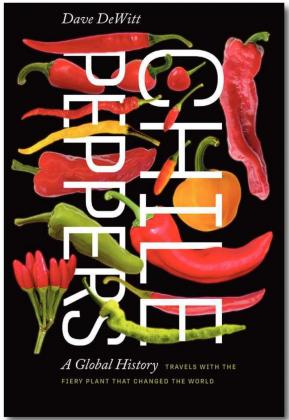Title: “Chile Peppers: A Global History”
Author: Dave DeWitt
Paperback: 7-inches by 10-inches, 376 pages with 152 color photos
Published: September 2020
Publisher: University New Mexico Press, www.unmpress.com
ISBN: 978-0-8263-6180-6
There are more than 50,000 different types of peppers. The list ranges from the bell variety that has virtually no “heat” to it; to banana peppers rated 100-500 on the Scoville index; and the poblano known as ancho chilis comes in at 1,000-2,000 on the Scoville; tabasco peppers rank 30,000-50,000, and Scotch Bonnet is ranked at 80,000-400,000. The Carolina Reaper holds the Guinness World Record for heat at 1,500,000-2,200,000 on the Scoville index.
Author Dave DeWitt, who has been dubbed the “Pope of Peppers,” is one the world’s foremost authorities on chile peppers, spices, and spicy foods. His latest culinary book traces the history of the wild plant from its domestication in the southern hemisphere, its introduction into Caribbean cuisine and Latin American culture, and the increasing popularity of spicy foods in U.S. culture. The genus Caspicium originated in this hemisphere in an area between southern Brazil and western Bolivia. Approximately 25 species of Caspicium flourished in South America before the first humans arrived 15,000 to 25,000 years ago explained DeWitt. The word “chili” is derived from the Nahuatl word, chilli. It is the fruit of plants from the genus Capsicum which are members of the nightshade family, Solanaceae.
The author highlights European cooks’ introduction to paprika and traces how African cuisine embraced the spicy “fruit,” which was introduced by European traders, specifically the Portuguese.
“It has a most violent hot taste, but the natives consume it in incredible quantities,” wrote Joachim Monteiro about his nineteenth century travels in Angola, Africa. “Their stews are generally of a bright-red colour from the quantity of this pepper added ... Their cookery is mostly a vehicle for conveying this chili pepper.”
Today North African cooks can choose from up to 200 different spices and herbs when replenishing kitchen supplies, according to one African cookbook.
Various chapters of DeWitt’s book describe his experiences in Asia including shopping at the Little India and Chinatown markets in Singapore in addition to sampling Malaysian and Indonesian restaurants and his culinary adventures in Japan. He includes the “Chicken And Beef Satay With Spicy Peanut Sauce” recipe which is a specialty of Chef Abdul Wahah, Equatorial Hotel, Penang, Malaysia.
Chapter Nine is dedicated to explaining why “hot means healthy.” The crystalline alkaloid capsaicin is the source of “heat” in chiles. This alkaloid retains its original potency despite the passage of time, cooking procedures, or freezing temperatures. Chiles are good sources of vitamins especially A and C. The author identifies a lengthy list of human ailments that can be alleviated using chile peppers, both topically applied and ingested.
And the pods have a unique role in folklore and legend.
DeWitt expounds on the legendary properties of the plant and describes ritualistic practices from numerous cultures. He includes a comment from Beatrice Roeder, author of Chicano Folk Medicine from Los Angeles, California.
“Chile is used as an amulet, probably because of its well-known protective pharmacological properties, and in religious ceremonies, witchcraft, and conjuring; its fiery potency is considered a powerful means to any end,” she wrote.
The final pages offer recipes such as Tournedos Con Salsa Chipolte, Classic British Mustard Sauce, and The Salmon And The Cure. Pico De Gallo Salsa, one of the numerous recipes the author shares, features serrano or jalapeno chiles along with fresh cilantro, diced tomatoes, and chopped onion as major ingredients.
There are nine and a half pages of sources identified in the bibliography in addition to a 12-page index to guide readers in their culinary adventures.
“Dave DeWitt is one of America’s most scientifically literate journalist, and reading of his travels is always an adventure,” wrote Gary Paul Nabhan, author of Why Some Like It Hot: Food, Genes, and Cultural Diversity.
About the author:
Dave DeWitt, a food historian, has published more than 50 books, including Precious Cargo: How Foods from the Americas Changed the World. DeWitt is the producer of the National Fiery Foods & Barbecue Show, Albuquerque, New Mexico. He founded the Scovie Awards, which recognize the world’s best fiery foods and barbecue products.
Visit www.unmpress.com or call 800-848-6224 for more information.

